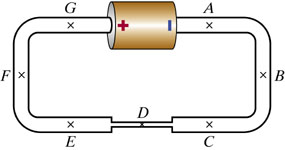Thin and Thick Wires
In this wiki page, you will learn about thin and thick wires and how they physically operate.
Wiki created by Ryan Keefe (rkeefe3)
The Big Picture
Let's start out by saying this: no matter how much the wire's thickness changes, if a wire has a current running through it, it will always have the same number of electrons passing through it every second. This value cannot change within the wire just because of thickness. What can change however is the magnitude of the electric field caused by the wire.
Electric Field(conceptual)
Because the electric field due to a wire can be formulated by this:
[math]\displaystyle{ E(R)=\frac{\lambda}{2 \pi \epsilon_0 R} }[/math]
Since electric field is inversely related to the radius of the wire, the thicker the wire, the less the magnitude of the wire. Funny enough though, if you take a wire (we will call this wire A) with a current and replace a section of the wire with a thinner wire (we will call this wire B) and measure the magnitude of the electric field at thick sites of the wires, we will find that wire A has a larger magnitude than wire B. Why is this? Well, analyzing wire B, one can find a large gradient of surface charge across the section of thin wire replacing the thick wire, meaning this area is acting like a funnel for electrons. This funnel means that the overall speed of the electrons going through the wire. This is true for the whole wire. As stated above, every wire has a constant number of electrons passing through it every second, also known as electron current. Because of this slow down due the thin wire, the value of [math]\displaystyle{ \lambda }[/math], which is charge per unit length, goes down making the electric field magnitude go down as well.
Electric Field(mathmatical)
Another formula for the relationship of thickness versus the magnitude of the electric field is:
[math]\displaystyle{ i=nAuE }[/math]
Where [math]\displaystyle{ i }[/math] is the electron current, [math]\displaystyle{ n }[/math] is the mobile charges per volume of wire, [math]\displaystyle{ A }[/math] is the cross sectional area of the wire, [math]\displaystyle{ u }[/math] is the electron mobility, and [math]\displaystyle{ E }[/math] is the magnitude of the electric field.
Example
Example 1
In the circuit below, all the wires are made of the same material, but a section of the wire is thin.
Which of the following are true?
- The electron current is the same at every location in this circuit.
- The magnitude of the electric field at location D is larger than the magnitude of the electric field at location G
- The magnitude of the electric field is the same at every location in this circuit.
- The magnitude of the electric field at location G is smaller in this circuit than it would be if all the wires were thick.
- Fewer electrons per second pass location E than location C.
- There is a large gradient of surface charge on the wire between locations C and E.
- There is no surface charge at all on the wire near location G.
- The electron current in this circuit is less than the electron current would be if all the wires were thick.
Let's go through the choices one at a time:
Choice 1: Is true, all wires that work have the same electron current or flow throughout.
Choice 2: Is true, because electric field strength is inversely related to the radius of the wire.
Choice 3: Is false, because there are wires of different thicknesses in the total wire.
Choice 4: Is true, because the thin wire in this one makes the electron current overall slower, than the electric field strength is also weaker with the thick wire.
Choice 5: Is false, because electron current is constant throughout the wire.
Choice 6: Is true, because of the funnel between the thick wire and thin wire that crowds up the electrons.
Choice 7: Is false, because point G is near the battery terminal.
Choice 8: Is true, because the thin wire is slowing everything up like a funnel through the wire.
Example 2
Using the picture from Example 1, let's say that the electron current is 5E18 1/s, there are 4E28 mobile electrons per cubic meter, the electron mobility is 0.00006 (m/s)(V/m), and that the radius of the thing wire is 0.2mm. What is the electric field strength around point D?
Solution: Using the equation [math]\displaystyle{ i=nAuE }[/math], one can solve this problem. Rearrange the equation and plug in the numbers.
[math]\displaystyle{ E_(D)=\frac{i}{nAU}=\frac{5*10^{18}}{4*10^{28}*\pi*(0.2*10^{-3})^{2}*0.00006}=1.66 V/m }[/math]
References
Matter & Interactions, Vol. II: Electric and Magnetic Interactions, 4th Edition
http://farside.ph.utexas.edu/teaching/302l/lectures/node26.html
